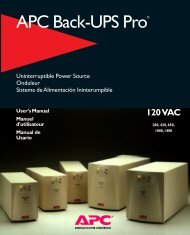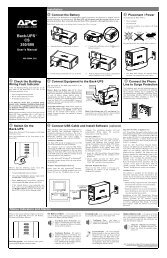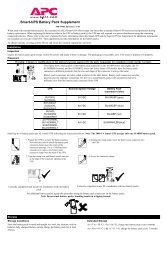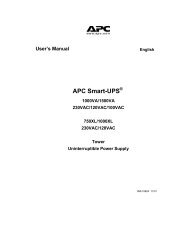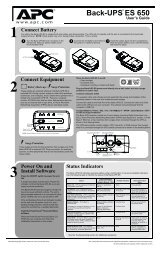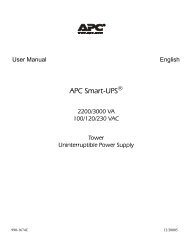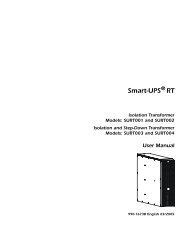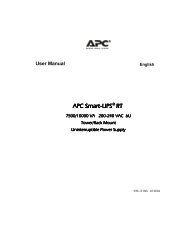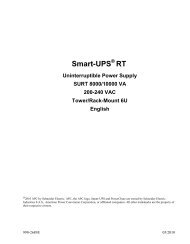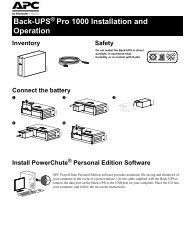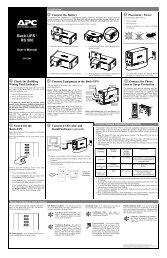APC Smart-UPS 5000 User Manual - ExcessUPS
APC Smart-UPS 5000 User Manual - ExcessUPS
APC Smart-UPS 5000 User Manual - ExcessUPS
You also want an ePaper? Increase the reach of your titles
YUMPU automatically turns print PDFs into web optimized ePapers that Google loves.
Initial Startup<br />
Rear Views<br />
<strong>5000</strong> VA Tower Model<br />
990-7032A, Revision 3 7/01 6<br />
<strong>5000</strong> VA Rack Mount Model<br />
Charge the battery<br />
The <strong>UPS</strong> charges its battery whenever it is connected to utility power. The battery will charge fully during the first four<br />
hours of normal operation. Do not expect full runtime during this initial charge period.<br />
Connect Computer Interface Port (Optional)<br />
Power management software and interface kits can be used with this <strong>UPS</strong>. Use only kits supplied or approved by the<br />
manufacturer. If used, connect the interface cable to the 9-pin computer interface port on the back panel of the <strong>UPS</strong>.<br />
Secure the connector’s screws to complete the connection.<br />
Caution:<br />
DO NOT use a standard serial interface cable to connect to the Computer Interface Port on the <strong>UPS</strong>. Standard<br />
serial interface cables are incompatible with the <strong>UPS</strong> connector. Use the cable provided with your <strong>UPS</strong>.<br />
Connect Ground Leads to TVSS Connector (Optional)<br />
The <strong>UPS</strong> features a TVSS connector for connecting the ground lead on transient voltage surge-suppression (TVSS)<br />
devices such as telephone and network line protectors. The TVSS connector provides grounding through the <strong>UPS</strong>’s power<br />
cord ground conductor. To make a connection to the TVSS connector, loosen the screw and connect the surge<br />
suppression device’s ground lead. Tighten the screw to secure the lead.<br />
Voltage Sensitivity<br />
The <strong>UPS</strong> detects line voltage distortions such as spikes, notches, dips, and swells, as well as distortions caused by<br />
operation with inexpensive fuel-powered generators. By default, the <strong>UPS</strong> reacts to distortions by transferring to on-battery<br />
operation to protect the loads. Where power quality is poor, the <strong>UPS</strong> may frequently transfer to on-battery operation. If<br />
the loads can operate normally under such conditions, battery capacity and service life may be conserved by reducing the<br />
sensitivity of the <strong>UPS</strong>.<br />
To reduce <strong>UPS</strong> sensitivity, press the configuration button on the rear panel. Use a pointed object such as a pen to<br />
press the button. Press it once to set the <strong>UPS</strong>’s sensitivity to reduced. Press it again to set the sensitivity to low. Press<br />
the button a third time to reset normal sensitivity.<br />
normal<br />
reduced<br />
low<br />
When the <strong>UPS</strong> is set to normal sensitivity, the configuration LED is brightly lit.<br />
When it is set to reduced sensitivity, the LED is dimly lit.<br />
When it is set to low sensitivity, the LED is off.



